Canon EOS T4i / 650D review
-
-
Written by Ken McMahon
Intro
The Canon EOS Rebel T4i, or EOS 650D as it’s known outside North America, is the company’s latest upper entry level DSLR. Announced in June 2012, it replaces the massively popular Rebel T3i / 600D which has held the upper entry-level position in the EOS line-up since its introduction in Feb 2011. Following Canon’s usual practice, the T3i / 600D won’t be discontinued, but will drop down the range to occupy a position just below the Rebel T4i / 650D.
To look at the headline specifications, you’d be forgiven for assuming not much has changed. The resolution remains at 18 Megapixels, the video is still 1080p, the AF system is the familiar Canon 9-point arrangement and the articulated 3 inch screen with a resolution of 1040k dots looks much the same.
Look a little closer though and you’ll discover an abundance of new features and improvements that make this a very different camera in terms of handling and performance from its predecessor. The screen is now touch-enabled and supports phone-style gestures like swiping and pinching as well as touch focusing and shooting. The AF system has been radically overhauled with cross-type sensors in all nine locations and a new hybrid AF system which embeds Phase Detect capabilities into the main imaging sensor, allowing it to perform better continuous autofocusing in Live View and movies. The processor has been updated to the latest Digic 5 which supports 25600 ISO and in-camera correction for colour fringing.
Other improvements include continuous shooting – boosted from 3.7fps to 5fps and two new multiple exposure shooting modes: Handheld NightScene mode is now joined by Multi shot noise reduction which allows you to choose the ISO sensitivity and HDR Backlight combines three shots to extend tonal range. Finally, Canon has announced two new lenses with Stepper Motor Technology for faster and quieter autofocus during video recording – an 18-135mm kit zoom and a new 40mm f2.8 pancake prime.
The natural rival to the T4i / 650D will be the successor to Nikon’s best-selling D5100, but until it’s announced I’m going to compare the quality against the D3200 as both cameras will almost certainly share the same – or a similar – 24 Megapixel sensor. So read on to find out how the quality compares and how well the new technologies work in practice!
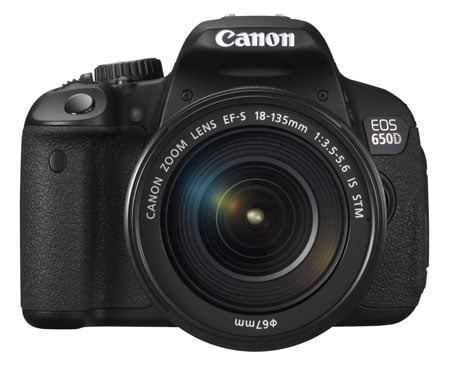 |
Canon Rebel T4i / EOS 650D design and controls
In terms of its external design, the Rebel T4i / EOS 650D looks very similar to its predecessor. It measures 133.1×99.8×78.8mm and weighs 575g including the battery and a card. Give or take less than a millimetre here or there, that’s the same size as the Rebel T3i / EOS 600D and a negligible 5 grams heavier.
Physically, you’d be hard pressed to tell these two cameras apart if you saw them in the street, though there are a few tell-tale signs. Apart from the name plate on the front of the body, the most obvious difference is a redesigned on-off switch which now has a third position for movie shooting which no longer appears on the mode dial. Built-in stereo mics are located in front of the hot shoe and the display button has disappeared. Beyond that, the only differences are cosmetic changes to the shape of the buttons on the rear panel.
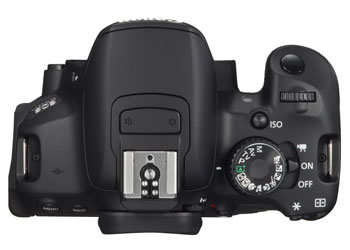 |
Nikon’s D3200 with card and battery weighs 505g and measures 125 x 96 x 76.5mm. So it’s slightly smaller and significantly lighter – a difference that’s exaggerated if you opt for the EF-S 18-135mm STM lens on the Canon and the DX 18-55mm VR on the Nikon. Of course for a smaller, lighter and cheaper package, you could alternatively buy the T4i / 650D with the EF-S 18-55mm kit lens, but as a non-STM model it lacks the quick and quiet movie AF of the EF-S 18-135mm STM and 40mm STM models. To put the new AF technology to the test, I tried the EOS T4i / 650D with the EF-S 18-135mm STM lens.
Apart from the relocation of the movie mode the mode dial is the same as on the T3i / 600D with the PASM modes followed by Scene intelligent Auto, Flash off, Creative Auto and a handful of scene modes ending with Handheld NightScene and the new HDR Backlight control. As before, the separate card compartment is located on the right side of the body and takes SD, SDHC, SDXC and UHS-1 cards. On the opposite side of the body behind a soft plastic flap you’ll find a mini HDMI port and a USB 2.0 port which doubles as an A/V output for analogue connection to a standard definition TV with the optional AVC-DC400ST cable. There’s a second flap which provides access to port for a cabled remote, and in addition to built-in stereo mics those who take their movie making seriously will be pleased to find an input socket for an external microphone.
On the bottom plate the tripod bush is mounted directly under the lens mount axis and the battery compartment door to the right of it. A quick release plate just barely obstructs the door so that you can’t open it, which is a shame, though you can get round the problem by fitting the plate sideways.
The rear panel landscape is very similar to that of the Rebel T3i / EOS 600D. In fact the button layout is exactly the same, though the shape of some of the buttons and the labelling has been altered. The AE / AF lock and AF point selection buttons remain in the top right corner and, as before, double-up as zoom controls during playback – along with manual focus assist controls in Live view and Digital zoom controls in the Movie mode.
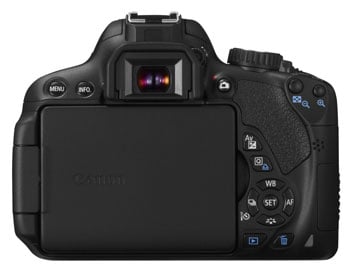 |
The rear of the camera remains dominated by the 3in screen – now touch sensitive, about which more in a moment. Introduced on the Rebel T2i / EOS 550D, then abandoned in favour of a DSP button on the T3i / 600D, the Rebel T4i / EOS 650D sees a return to the proximity sensor to automatically switch the screen off when the viewfinder is in use. This time the sensor is mounted above the viewfinder to the rear of the hotshoe, a position in which it functions perfectly well. The dedicated Live View button remains to the right of the viewfinder.
The controls to the right of the screen remain identical to the 550D / T2i, but the panel has been subtly reshaped allowing them a little more space with the labelling on the cross-keys moved onto the body rather than the buttons themselves – I never heard of anyone having problems with them rubbing off, but who knows? Starting at the top you’ll find the AV exposure compensation button, followed by the Q button to enter the Quick Access menu which now responds to touch-control.
Below these are the traditional four cross-keys which share the same functions as the earlier 600D / T3i. Push up for White Balance, right for AF mode, down for Picture Style and left for the drive modes. Below these are buttons for play and delete. Canon has kept the depth-of-field preview button which can be found just below the 650D / T4i’s lens release button; this works when composing with either the optical viewfinder or in Live view.
The Canon Rebel T4i / EOS 650D is powered by the same LP-E8 Lithium Ion battery pack used in its two predecessors. This has an 1120mAh rating and Canon quotes exactly the same battery life as the T3i / 600D – 440 under CIPA conditions with 50% flash usage. The number of shots understandably falls considerably when composing with the screen. Switch to movie mode and you should be able to film approximately 100 minutes worth of footage per charge. Either way if you regularly compose in Live view or shoot movies, you’ll find your battery depleting sooner rather than later, so I’d definitely recommend carrying a spare.
There’s still only four levels on the battery life indicator, compared to the accurate percentage remaining shown by Sony’s Info Lithium models. If you require longer lifespan not to mention something more to hold onto, the optional BG-E8 battery grip can take two LP-E8 packs or six AA batteries, while providing portrait controls and grip. Alternatively if you prefer mains power, there’s an optional ACK-E8 adapter.
The Rebel T4i / EOS 650D is equipped with the same internal flash as its predecessor, which has a guide number of 13. The pop-up unit can be used in auto and manual modes, has a red-eye reduction mode, Flash exposure compensation and the choice of 1st or 2nd curtain sync. As before, there’s a hotshoe for mounting external Speedlite flashguns and the fastest sync speed remains 1/200. As you’d expect for a consumer model, there’s no PC Sync port, but the T4i / 650D inherits its predecessor’s support for wireless control and the latest video light equipped Speedlites.
The built-in flash can be used as a master to wirelessly trigger compatible Speedlites and you can choose from NormalFiring, EasyWireless and CustWireless. EasyWireless greys-out all the advanced options, simply leaving the control channel and exposure compensation settings. This means all you need to do is match the channel of the slave unit and you’re ready to go, which allows beginners to enjoy the benefits of wireless flash control without the complications. You can trigger multiple units sharing the same channel, although without separate control over their output.
More advanced photographers will be pleased to find greater control under the CustWireless option, which unlocks the options to set the Wireless Function and the ratio between built-in and external units. Slave units can also be divided into two groups and the ratio between them set. Like its predecessors, there’s also control for compatible Speedlites mounted directly to the hotshoe, allowing you to adjust the compensation, bracketing, sync, zoom and wireless options without touching the flash.
Canon Rebel T4i / EOS 650D Viewfinder and Screen
The Rebel T4i / EOS 650D retains the penta-mirror optical viewfinder of its predecessor with 95 percent coverage and 0.85x magnification. That’s about the same as most DSLRs in this class, though differences in sensor sizes and the methods used to produce magnification specifications make comparison difficult. The Nikon D3200’s pentamirror viewfinder has 95 percent coverage and 0.8x magnification, so on paper it’s similar, but when I look through the one, then the other, the Rebel T4i / EOS 650D’s viewfinder appears bigger. Having said that, if the view through the viewfinder is important to you, then a body with a pentaprism, though heavier, will provide a far bigger brighter view – for that you’re looking at shifting up a notch to the EOS 60D or D7000.
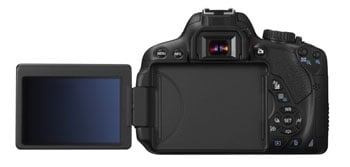 |
The 3 inch articulated screen is the same size and resolution as its predecessor, but is now touch-sensitive – a first for a Canon DSLR. This is a capacitive type screen rather than a pressure-sensitive one which means it’s very responsive and supports multi-touch gestures that most people will be familiar with from mobile phone and tablet use.
Touch screens on consumer cameras have enjoyed a fairly positive reception, but reaction from enthusiast photographers has been mixed. The good news is that Canon has integrated the touch-screen into the Rebel T4i / EOS 650D incredibly well. Touch operation augments the existing physical controls rather than replacing them, to the point that it’s perfectly possible to turn the touch-screen off and operate the camera without it, though in my view that would be a mistake. I’ll talk in more detail about the touch screen functions in the handling section at the end of the review.
Canon Rebel T4i / EOS 650D lens and stabilisation
The Rebel T4i / EOS 650D employs the Canon EF lens mount and is compatible with all EF and EF-S lenses. The APS-C sensor reduces the effective field of view by a factor of 1.6. Two new lenses have been announced with this model; the new EF-S 18-135 f3.5-5.6 IS STM kit lens and the EF 40mm f2.8 STM pancake prime. The STM indicates that these lenses are fitted with stepper motors for AF; commonly used on mirrorless compact system cameras, these provide silent AF operation making them ideal for movie shooting with continuous AF. In combination with the Rebel T4i / EOS 650D’s new Movie Servo AF mode these lenses promise a practicable continuous movie AF for the first time on a Canon DSLR. I’ll talk more about how the system works in practice in the video section.
The effective range of the 18-135 STM kit lens is 29-216mm making it an excellent all-purpose kit lens. The EF 40mm f2.8 STM works out at a rather unusual 64mm on the T4i / 650D and other APS-C Canon bodies – a little long for a standard lens and on the short side for a portrait lens. Although it’s available as a kit option with the T4i / 650D, it actually makes more sense on a full frame body where it provides a slightly wider field of view than a ‘standard’ 50mm and I can see it being a popular lens with 5D owners. Of course without Movie servo AF on existing Canon bodies the STM features are partly redundant, but I’d be surprised if this technology doesn’t eventually find its way into higher end and full frame Canon bodies.
Canon Rebel T4i / EOS 650D with EF-S 18-135mm IS STM coverage wide | Canon Rebel T4i / EOS 650D with EF-S 18-135mm IS STM coverage tele | |
 | 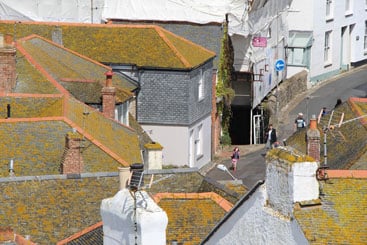 | |
| 18-135mm at 18mm (29mm equivalent) | 18-135mm at 135mm (216mm equivalent) |
I tested the Rebel T4i / EOS 650D with the EF-S 18-135 f3.5-5.6 IS STM kit lens. The lens has three buttons on the right side of the barrel. One locks the zoom ring to prevent accidental operation or ‘creep’ when the lens is pointed up or down. A second switch activates the stabilisation and a third switches between AF and manual Focus. Manual focus is ‘fly by wire’ rather than a direct physical coupling and you can focus manually even when the switch is in the AF position.
To test the stabilisation I zoomed the lens to its maximum 216mm equivalent focal length and took a series of shots in Shutter priority mode at different shutter speeds with the stabiliser in the on and off positions. As you can see from the crops below, the lens lives up to Canon’s claims of four stops of image stabilisation producing sharp results at speeds down to 1/8th.
Canon Rebel T4i / EOS 650D with EF-S 18-135mm IS STM image Stabilisation off/on | ||||
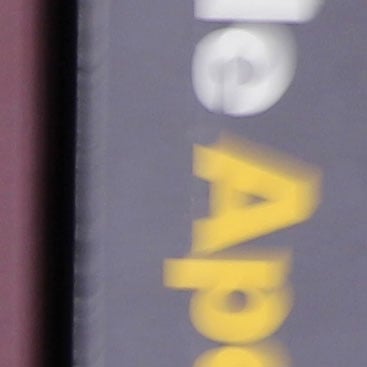 |  | |||
100% crop, 18-135mm at 135mm 100 ISO 1/8th IS off. | 100% crop, 18-135mm at 135mm 100 ISO 1/8th IS on. | |||
Canon Rebel T4i / EOS 650D shooting modes
The Rebel T4i / EOS 650D uses the same 63-zone iFCL metering system as its predecessor and other APS-C models from the 1100D up to the 7D. There are four modes – Evaluative (the default), Partial, Spot and Centre-weighted. Evaluative proves pretty accurate for most subjects but it’s good to have the other option for backlit subjects, and other situations where the subject or lighting demand it.
Alternatively you could simply switch to Scene Intelligent Auto which uses Scene detection popular in Canon’s compact range to determine the best exposure. In addition to the PASM modes, other positions on the mode dial include Creative Auto for accessible control over depth of field, white balance, exposure compensation and other settings, followed by seven scene modes. The last two of these are composite modes; Handheld NightScene which takes four shots at a preset ISO sensitivity and combines them for a low-noise result is retained from the Rebel T3i / EOS 600D, HDR Backlight Control is new and takes three consecutive shots which in combination produce a result with extended dynamic range. This mostly works to retain highlight detail as shown in the example below. HDR Backlight Control sets the ISO sensitivity automatically. For the example below the metering selected 640 ISO, the shot shown alongside was taken in Aperture priority mode at 400 ISO. As you can see, the HDR version retains quite a bit more detail in the highlights around the stained glass window which are more clearly visible in the cropped areas below the full frame.
Canon Rebel T4i / EOS 650D with EF-S 18-135mm IS Aperture Prority | Canon Rebel T4i / EOS 650D with EF-S 18-135mm IS HDR Backlight Control | |
 |  | |
 | 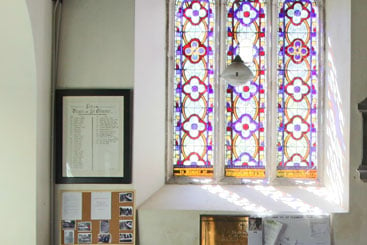 |
Exposure compensation is available in 1/3 of a stop increments up to a generous plus or minus five stops and auto exposure bracketing can be set for three shots up to 2EV apart again in 1/3EV increments. If you like your HDR, this may strike you as a little basic, but it’s better than no AEB at all, which is what the Nikon D3200 has to offer. On the other hand it’s a little disappointing to see the Rebel T4i / EOS 650D tread water here, rather than provide a 5 or even 7-frame AEB option as found on Sony Alpha SLT models as well as many Mirrorless compact system cameras.
The T4i / 650D retains the Picture styles of its predecessor which apply sharpness, contrast, saturation and colour styles as collective presets with the choice of Auto, Standard, Portrait, Landscape, Neutral, Faithful and three User Defined options. A Monochrome option offers four filter and four toning effects. Also unchanged from the T3i / 600D are Auto Lighting Optimizer, which which adjusts the brightness and contrast of images with dark areas and Highlight Tone Priority, which expands the dynamic range to retain detail in image highlights.
The Rebel T4i / EOS 650D also inherits Peripheral illumination correction, which is optionally applied to JPEG images to reduce the effect of vignetting where the image darkens towards the corners. Peripheral illumination correction is enabled by default providing the attached lens is in the camera’s database (the EF-S 18-135 f3.5-5.6 IS STM is included) and in keeping with the Cameralabs policy of using default settings for testing was enabled for both the outdoor and high ISO noise tests.
Colour fringing correction is a welcome new addition, a feature inherited this time not from the Rebel T3i / EOS 600D, but the mid-range EOS 60D. This isn’t enabled by default, so it was disabled for our test results, however, the 100 percent crops below show how effective it is.
Canon Rebel T4i / EOS 650D Chromatic aberration correction disabled | Canon Rebel T4i / EOS 650D Chromatic aberration correction enabled | |
 |  | |
EF-S 18-135mm f3.5-5.6 IS STM f3.5 100 ISO | EF-S 18-135mm f3.5-5.6 IS STM f3.5 100 ISO |
Canon Rebel T4i / EOS 650D movie modes
The Rebel T4i / 650D retains the movie modes of it’s predecessor. Set to PAL they are 1080p25, 1080p24 720p50 and 640p25. Switch to NTSC and the 25 and 50fps modes are substituted for 30 and 60fps modes.
As before, video is encoded using H.264 with uncompressed PCM audio and stored in a QuickTime MOV wrapper and you’ll need a Class 6 (or higher) SD card to support the maximum recording times. The maximum single clip recording time remains 29 minutes and 59 seconds. There’s also a single file size limit of 4GB. You’re looking at about 330MB per minute in any of the HD movie modes, with the 720 option consuming the same as the 1080 due to its higher frame rates. So that 4GB file limit will actually be reached after approximately 12 minutes, regardless of the HD quality setting. When this happens, a new file is automatically created without interruption to the recording. A fully charged battery should last for about one hour and 40 minutes worth of recording.
The mono microphone of the Rebel T3i / EOS 600D has been upgraded and the T4i / 650D now sports stereo mics as well as retaining the 3.5mm jack for an external microphone. Audio recording levels are set to automatic by default, but can be set manually via the Sound recording menu page where there are also wind filter and attenuator options. The T4i / 650D also retains the Video snapshot feature introduced on the T3i / 600D which captures a series of short clips at predefined lengths of 2, 4 or 8 seconds and adds them all to an album.
One other option introduced on the T3i / 600D that hasn’t been retained, however, is the digital zoom, which offered a cropped frame zoom factor of between 3x and 10x. That’s a bit of a shame, particularly as, in the absence of the Movie crop function on the earlier 550D, there’s now no option to extend the movie zoom range beyond the optical range of the lens.
To enter Movie mode you now push the on/off switch into a third position indicated by a movie camera icon. In Program Auto mode aperture, shutter speed and ISO sensitivity are all set automatically, but turn the mode dial to the M position and you have full control over all three.
Probably the biggest change to movie recording on the Rebel T4i / EOS 650D is provided by the touch-screen in combination with the Hybrid AF. It not only allows you to touch-focus, but does it quietly (providing you have one of the STM lenses fitted), quickly and accurately. It really does mark a step-change in movie autofocus capability on Canon DSLRs.
The T4i / 650D goes one step further than touch-screen mirrorless cameras by providing touch-buttons on the screen, one of which allows you to toggle the Servo AF mode. This allows you to use the touch screen to cue up your focus change before (gently) tapping the Servo AF button to action it. In Manual exposure mode there are also touch buttons for adjusting the aperture, shutter speed and ISO during recording and, as with all the camera functions, you can also make these changes using the physical buttons.
It all adds up to a very satisfying experience providing a very high degree of control, but it isn’t flawless. The phase detect sensors are located in the central portion of the screen which means that if your subject strays towards the edge of the frame the AF either picks something more centrally located to lock onto or switches to a slower contrast-based system. And when the camera is very unfocssed, for example when switching from a close up to a long shot, it frequently takes an age, by which I mean several seconds, to respond. As this is something phase detect AF is supposed to be good at, I can only hope that it’s a question of optimising firmware and Canon will be able to improve drastically on the Rebel T4i / EOS 650D’s performance in this area.
| |
|---|---|
|
Our first look at the video from the T4i / 650D is promising. This clip and all the others were shot at the best quality 1080p25 mode. The stabilisation works well and there’s no noise whatsoever from the AF motor. Manual zooming a lens like this during movie recording alsways presents a challenge, but the 18-135mm STM kit lens has a big zoom grip and the action is quite smooth.
| |
|---|---|
|
For this tripod mounted panning shot the stabilisation was disabled. Servo AF was enabled and the focusing is rock steady with none of the frantic seeking that you get with contrast detect systems. Even during the zoom the focus stays locked on the boat.
| |
|---|---|
|
Other DSLRs with a C-AF video mode, the Nikon D3200 for example, get very upset with this scene, constantly adjusting the focus and never settling. The Rebel T4i / EOS 640D takes it all in its stride though. This clip was shot in Program auto mode and the exposure adjustment as the camera pans past the window is a little strong as is common on Canon models.
| |
|---|---|
|
Here’s an example of the Rebel T4i / EOS 650D’s touch focusing in action. This time the camera is in manual mode with the aperture set to f4 and the ISO set to Automatic. The first thing to point out is there is no audible sound from the 18-135mm STM lens motor as the focus moves from the beer glass to the bar and back. The focus adjustment is quite positive, particularly in the direction of the bar, a little less so coming back to the glass. That might be a consequence of the low light conditions, but it’s an impressive performance nonetheless.
| |
|---|---|
|
Focusing performance of the Rebel T4i / 650D with a non STM lenses will be an important consideration for those with an existing investment in Canon lenses, particularly if the Hybrid AF sensor finds its way into other models further up the range and while there are only a small number (currently two) of STM lenses available. Here’s the same touch focus example, this time with the EF-S 10-22mm f3.5-4.5. Note that the AF performance isn’t affected (if anything the focus adjustments are quicker and surer) and the noise of the AF motor in the 10-22mm, while audible, isn’t overly intrusive.
| |
|---|---|
|
The Rebel T4i / EOS 650D has Face Detect but it doesn’t pick up until people are quite close. For this tracking shot with the kit lens at its maximum 135mm zoom and the aperture set wide open at f5.6 I used the touch screen to lock focus on the woman’s shirt and the AF system has kept with her all the way until she exits the frame. Overall this is an impressive upgrade in continuous autofocusing over the previous Canon and Nikon DSLRs, although Sony’s SLTs and Nikon’s 1 models also enjoy phase-detect AF while filming for a similar effect.
Canon Rebel T4i / EOS 650D
handling
The addition of the touch screen turns the Rebel T4i / EOS 650D into a very different model in handling terms to its predecessor the Rebel T3i / EOS 600D. The first thing to say about the touch screen is that if you don’t like it you can disable it and the T4i / 650D will function in exactly the same way as other Canon DSLRs – none of the camera’s operation or functions rely exclusively on the touch screen.
The screen can of course be used to navigate and select menu items. The interesting thing here is that Canon has barely had to modify the icons and menu screens, which are broadly the same as on the T3i / 600D, but nonetheless work pretty well for touch-control. About the only problem I had was with the small menu page icons at the top of the screen but, with a little practice, even these didn’t present much of a problem. When selected, most of the menu items display a new page with the relevant options presented as large touch-icons. Where a finer degree of control is required, for example on the auto bracketing screen, you have three options; you can drag sliders, tap nudge buttons or resort to the physical command dial or cross-keys. The screen is very accurate and responsive and you can get most things done without having to try.
Beyond the main menu system the touch screen really comes into its own in Quick control mode. As before, shooting information is displayed on the main screen and you can enter Quick control mode by pressing the Q button on the rear panel then use the cross-keys to select functions, the main dial to change the selected option or the set button to enter a dedicated menu page for the selected item. You can also use the touch screen to activate, select and set each of these options. It requires an additional step, as using the touch screen means you have to enter the dedicated menu page and don’t have the option of scrolling through the options for a highlighted setting as you do with the main dial. Even so, after the first few minutes of doing things this way it feels perfectly natural. It isn’t that after using it you’ll never go back to doing things the old way. In fact, the touch-screen and physical controls work very well in combination which is a real credit to Canon. There aren’t many first-generation touch-screens that fit so seamlessly into a design engineered primarily for physical operation.
You can also use the touch-screen in Live view mode to access Quick control, set the focus point, make exposure adjustments, magnify for manual focussing and even operate the shutter.
A radically upgraded AF system is the biggest thing that sets the Rebel T4i / EOS 650D apart from its predecessor or indeed any Canon DSLR before it. As before the T4i / 650D has a traditional phase detect AF system which operates when the optical viewfinder is in use. This has been upgraded with cross-type sensors for all nine positions rather than just the central one as on the T3i / 600D. The central sensor is now a high-precision dual cross point – which basically combines a + oriented cross point sensor with a diagonal x oriented one. This high precision point is more accurate than the ‘normal’ precision AF sensors, but will only operated to the higher precision with lenses with a maximum aperture of f2.8 or wider, for example the new 40mm f2.8 pancake prime.
Switch to Live view or movie mode and, where earlier models relied solely on a contrast detect system, the T4i / 650D employs what Canon calls Hybrid CMOS AF. New phase detect AF points on the actual imaging sensor itself perform the initial focusing which is then fine-tuned using the the contrast detect system. In theory this should mean faster, more accurate AF because the phase detect system knows whether the subject is in front of or behind the current focus point, thus avoiding the back and forth ‘hunting’ of contrast detect only systems.
In practice, the hybrid system is an improvement on contrast detect only systems of earlier models, but its performance in terms of speed falls a long way short of the viewfinder phase detect AF. The T4i / 650D retains AF ‘Quick mode’ which momentarily disables live view and flips the mirror down so that the main phase detect array can be used to focus; the mirror then flips back up and live view is reactivated before pressing the shutter button all the way down to take the shot. So Canon clearly recognises that Hybrid AF has some way to go to rival either its own viewfinder-based PDAF system or the fast CDAF systems of mirrorless models from Olympus, Panasonic and Sony. For now at least, Hybrid CMOS AF is of most benefit while recording video, where the ability to focus accurately and consistently is crucial and where DSLR contrast detect AF systems have until now proved lamentably inadequate to the task.
Canon Rebel T4i / EOS 650D Continuous shooting
The Canon Rebel T4i / EOS 650D offers one continuous shooting mode with a quoted speed of 5fps – a significant improvement on the 3.7fps of its predecessor. The buffer can hold 22 large Fine JPEGS or 8 RAW files. To put these figures to the test I fitted the Rebel T4i / EOS 650D with a formatted 8GB SanDisk Extreme Pro UHS-1 card. In Large Fine JPEG mode at 100 ISO the T4i / 650D fired off 100 frames at a consistent 5fps. Switching to RAW, the T4i / 650D fired six frames in 1.1 seconds before stalling – a little faster than 5fps. Interestingly, switching the UHS-1 card for a SanDisk Extreme card with a Speed Class rating of 10 made no appreciable difference to the results.
Providing you’re happy to shoot JPEGs the T4i / 650D provides fairly respectable continuous shooting performance. It compares favourably with the Nikon D3200’s 4fps rate, though with a smaller buffer you get a shorter burst in RAW mode – 6 frames compared with 14 on the D3200. For ‘proper’ continuous shooting performance on a Canon DSLR, you’ll need to move up to the semi-pro models. The 60D isn’t much faster at 5.3fps, but it has a bigger buffer enabling you to shoot 16 RAW images or JPEGs until you run out of memory. If fast continuous shooting is a priority you should be looking at the 7D with a top speed of 7fps and a buffer sufficient for 25 RAW images. Action fans should also consider Sony’s SLTs as they offer faster continuous shooting than comparably-priced DSLRs.
Canon Rebel T4i / EOS 650D Sensor
The Rebel T4i / EOS 650D has an 18 Megapixel sensor measuring 22.3 x 14.9mm producing images with a maximum size of 5184 x 3456 pixels and a 3:2 aspect ratio. The sensitivity range runs from 100 to 25600 ISO and the shutter speed range is 30 – 1/4000 with a fastest flash sync speed of 1/200.
Image data can be saved in camera RAW format or as JPEGs at one of two compression settings. The best quality Fine Large JPEGs have a file size between 6 and 10MB.
To see how the quality of the Rebel T4i / EOS 650D measures-up in practice, take a look at my Canon T4i / 650D quality and Canon T4i / 650D noise results pages, browse my Canon T4i / 650D sample images, or skip to the chase and head straight for my verdict.
 Its 3 inch touch-screen, another first on a Canon DSLR, is intended to pull in compact upgraders and will succeed, but even those who love to use physical controls will find it enhances the handling characteristics in a very positive fashion. Other enhancements, like built-in stereo microphones, 5fps continuous shooting, the Multi shot noise reduction stacking mode and built-in correction for chromatic aberration make the Rebel T4i / EOS 650D an excellent all-round performer and a hard act to beat for first time buyers with a little extra in the budget or those looking to move up to the next level. I highly recommend it.
Its 3 inch touch-screen, another first on a Canon DSLR, is intended to pull in compact upgraders and will succeed, but even those who love to use physical controls will find it enhances the handling characteristics in a very positive fashion. Other enhancements, like built-in stereo microphones, 5fps continuous shooting, the Multi shot noise reduction stacking mode and built-in correction for chromatic aberration make the Rebel T4i / EOS 650D an excellent all-round performer and a hard act to beat for first time buyers with a little extra in the budget or those looking to move up to the next level. I highly recommend it.



